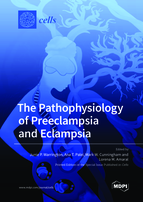The Pathophysiology of Preeclampsia and Eclampsia
A special issue of Cells (ISSN 2073-4409). This special issue belongs to the section "Reproductive Cells and Development".
Deadline for manuscript submissions: closed (31 December 2021) | Viewed by 68181
Special Issue Editors
2. Department of Neurobiology & Anatomical Sciences, University of Mississippi Medical Center, Jackson, MS, USA
Interests: pregnancy; preeclampsia; seizures; cerebrovascular function; angiogenesis; neuroinflammation; cognition; learning and memory; cerebral blood flow; pericytes; microglia; capillaries; blood-brain barrier
Special Issues, Collections and Topics in MDPI journals
Interests: Cell-free DNA; hypertensive pregnancy; matrix metalloptoteinase; nitric oxide; obese pregnancy; pharmacogenomics; preeclampsia; reactive oxygen species
Interests: pregnancy; preeclampsia; oxidative stress; mitchondrial dysfuncton; fetal programming; endothelial dysfuntion; renal hemodynamics; nitric oxide bioavailability; hypertension; cerebrovascular dysfunction; inflammation
Special Issue Information
Dear Colleagues,
Preeclampsia is a hypertensive disorder of pregnancy, diagnosed after the 20th week of gestation in women experiencing new-onset hypertension along with symptoms affecting the liver, kidneys, or brain. In some cases, women with preeclampsia go on to experience novel seizures, at which time they are diagnosed with eclampsia. The mechanisms contributing to pre-eclampsia and eclampsia are not fully elucidated, although the placenta seems to play a critical role. Previous studies suggest that improper placentation stimulates mitochondrial dysfunction and the exaggerated release of placental-derived molecules including inflammatory cytokines, anti-angiogenic factors, reactive oxygen species, and cell-free nucleic acids in the maternal circulation that cause systemic vascular dysfunction. These, along with maternally derived molecules, act in concert, leading to hypertension and target organ damage during pregnancies complicated by pre-eclampsia and eclampsia.
In this Special Issue, we invite original research articles, reviews, and mini-reviews on topics relevant to the pathophysiology of pre-eclampsia and eclampsia. Articles focused on potential mechanisms and therapeutic targets during pregnancy are preferred, but research on the post-partum period and effects on the offspring of pregnancies complicated by pre-eclampsia and/or eclampsia will also be considered.
Dr. Junie P Warrington
Dr. Ana T. Palei
Dr. Mark W. Cunningham
Dr. Lorena M. Amaral
Guest Editors
Manuscript Submission Information
Manuscripts should be submitted online at www.mdpi.com by registering and logging in to this website. Once you are registered, click here to go to the submission form. Manuscripts can be submitted until the deadline. All submissions that pass pre-check are peer-reviewed. Accepted papers will be published continuously in the journal (as soon as accepted) and will be listed together on the special issue website. Research articles, review articles as well as short communications are invited. For planned papers, a title and short abstract (about 100 words) can be sent to the Editorial Office for announcement on this website.
Submitted manuscripts should not have been published previously, nor be under consideration for publication elsewhere (except conference proceedings papers). All manuscripts are thoroughly refereed through a single-blind peer-review process. A guide for authors and other relevant information for submission of manuscripts is available on the Instructions for Authors page. Cells is an international peer-reviewed open access semimonthly journal published by MDPI.
Please visit the Instructions for Authors page before submitting a manuscript. The Article Processing Charge (APC) for publication in this open access journal is 2700 CHF (Swiss Francs). Submitted papers should be well formatted and use good English. Authors may use MDPI's English editing service prior to publication or during author revisions.
Keywords
- Preeclampsia
- Eclampsia
- Placental pathology
- Inflammatory cytokines
- Reactive oxygen species
- Anti-angiogenic and angiogenic factors
- Cell-free nucleic acids
- Mitochondrial dysfunction
- Vascular dysfunction
- Seizures







